Seven Inspiring Case Studies Showcasing the FLOWASSIST Seal
This case study compilation highlights seven real-life scenarios involving patients with various ostomy challenges who were successfully supported by the FLOWASSIST Seal. These case studies, carried out by qualified stoma care professionals in collaboration with Rhodes Pharma Ltd., Ostoform’s UK distribution partner, provide valuable insights into the effectiveness of this innovative solution for ostomy care.
Each case presents a unique set of circumstances, including different types of ostomies, complications, and specific patient needs. Through the expertise and guidance of healthcare professionals, the implementation of the FLOWASSIST Seal has resulted in positive outcomes, significantly improving the patients’ quality of life, and managing their ostomy-related issues effectively.
The healthcare professionals involved in these case studies played a crucial role in assessing patient needs, selecting appropriate interventions, and monitoring the outcomes. Their expertise and clinical supervision ensure that the FLOWASSIST Seal is utilized in a safe and optimal manner, providing patients with the best possible care and support.
The patient and nurse feedback, and quotes featured in these case studies underscore the positive impact and success achieved through the collaborative efforts of healthcare professionals and the utilization of the Ostoform Seal. Their experience and expertise validate the efficacy of the FLOWASSIST Seal as a reliable solution for managing ostomy-related challenges and contribute to the growing body of evidence supporting its effectiveness in enhancing the well-being of ostomy patients.
Case Study 1: Urostomy Patient Experiencing Severe Leakage
Patient History
A 60-year-old patient with a urostomy and a retracted stoma was experiencing severe leakage issues. Initially, a convex seal with a convex pouching system was used to manage his output. However, despite these measures, the patient faced frequent leakage episodes, occurring up to 5 times per day. This persistent leakage not only caused physical discomfort but also led to recurring flare-ups of sore skin, further exacerbating the situation.
Intervention
The patient was introduced to the FLOWASSIST Seal, which was used in conjunction with a convex pouching system.
Feedback
The patient reported that the FLOWASSIST Seal “has been a raging success”. He was able to change his baseplate once every 4 days and had not experienced any leaks since using the FLOWASSIST Seal. This improved pouching system reliability allowed his skin to recover, and it is now healthy. After 3 weeks of using the FLOWASSIST Seal, he was switching to a 2-piece flat pouching system.
Conclusion
The implementation of the FLOWASSIST Seal has transformed this patient’s life. Previously, he lived with uncertainty about how many times he would have to change his pouch each day, which affected his daily activities. With the FLOWASSIST Seal, he can reliably change his pouch once every 4 days. Before using the FLOWASSIST Seal, he explained he sometimes did not want to leave the house, now he is going out dancing.
Case Study 2: Ileostomy Patient with Complex Fistula
Patient History
This case study involves a patient who underwent a new end ileostomy after jejunostomy reversal. Unfortunately, she developed a complex fistula post-operatively, with output exceeding 1 litre per day. To manage this high output, the patient required a specialized high output system with a flow collector and daily Total Parenteral Nutrition (TPN). The fistula was positioned downward and tracked at 1 o’clock, presenting unique challenges for effective management.
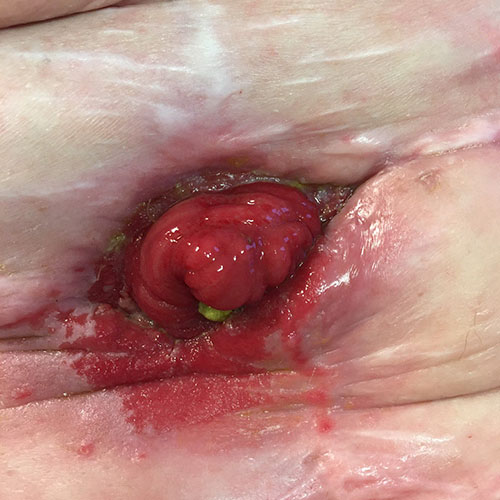
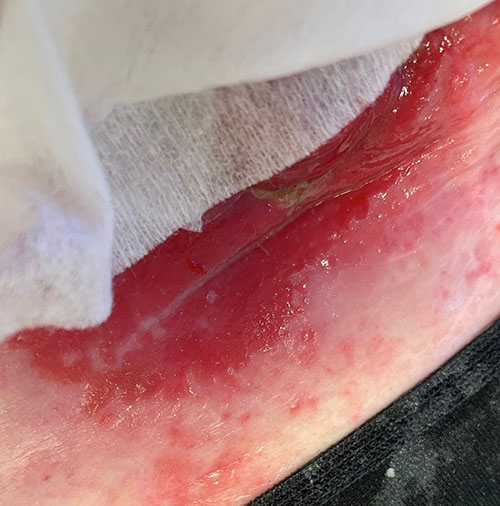
Intervention
Recognizing the need for an innovative solution to manage the complex fistula, the patient’s healthcare team introduced the FLOWASSIST Seal into her ostomy care regimen. Although the FLOWASSIST Seal is primarily designed for stoma management, it was used off-label on the fistula under clinical supervision, given its potential benefits.
Due to the positioning of the fistula, two large FLOWASSIST Seals were utilized to effectively manage the condition. This adaptation allowed the patient to change their appliance 2-3 times per day, ensuring effective containment and control of the fistula output.
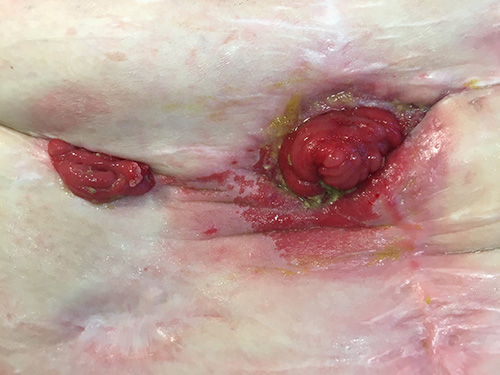
Within 2 days of using the FLOWASSIST Seal, the patient experienced significant improvements and was able to go home for the first time in months.
After 4 days of using the FLOWASSIST Seal, the patient’s skin was no longer painful to touch, and her appliances were comfortable and manageable.
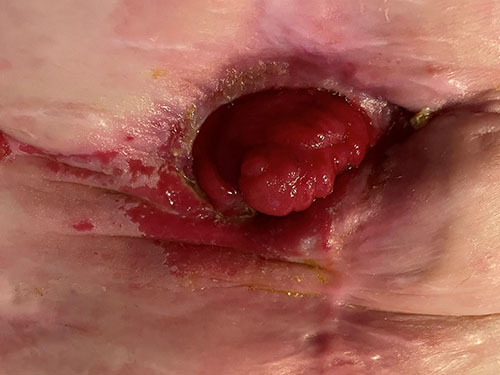

After 11 days of using the FLOWASSIST Seal, the patient’s skin condition had significantly improved.
Subsequent to this case study, the patient had surgery to refashion her ileostomy and surgical intervention on the fistula. The patient is now using the FLOWASSIST Seal on her ileostomy with positive results.
Conclusion
The case study highlights the potential of the FLOWASSIST Seal to revolutionize ostomy care. By adapting its use off-label under clinical supervision, the FLOWASSIST Seal provided significant benefits in managing the complex fistula, improving comfort, and enhancing the patient’s quality of life.
While this case study yielded promising results, it is essential to note that off-label usage should be carefully evaluated and implemented under clinical guidance. As healthcare professionals continue to explore innovative solutions, the FLOWASSIST Seal demonstrates its potential to enhance ostomy care, even in complex cases such as complex fistulas. Further research and collaboration between healthcare providers and manufacturers will unlock greater possibilities for optimizing ostomy management and improving the lives of patients.
Case Study 3: Ileostomy Patient with Extreme Leakage from Pancaking
Patient History
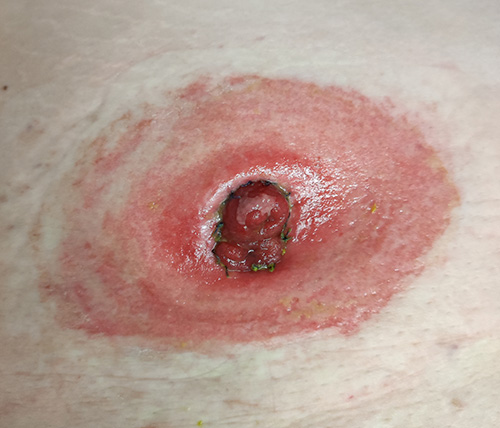
In this case study, a 40-year-old post-op ileostomy patient with a retracted stoma was experiencing extreme leakage issues due to pancaking (up to 10 times per day). The constant leakage caused irritation and soreness of the peristomal skin, making it sensitive to touch. The patient’s quality of life was greatly affected, requiring them to change their pouching system an average of 8 times per day.
Intervention
Recognizing the need for a reliable solution to manage extreme pancaking, the patient’s healthcare team introduced the FLOWASSIST Seal into their ostomy care regimen. The combination of the FLOWASSIST Seal with a 1-piece flat drainable pouching system offered a promising approach to tackle the challenges associated with pancaking and leakage.
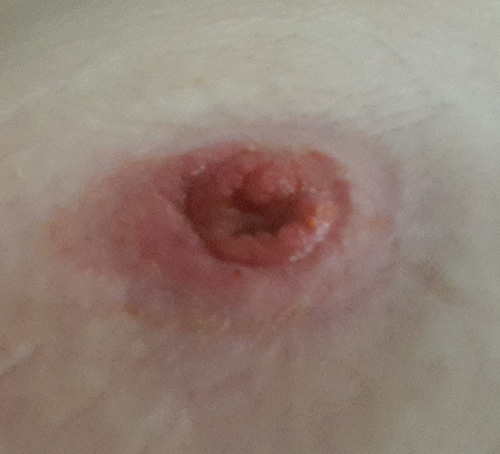
Feedback
Following the introduction of the FLOWASSIST Seal, the patient reported a dramatic reduction in pancaking occurrences. The leakages are now under control and their skin is in much better condition.
Conclusion
The advanced design of the FLOWASSIST Seal helped to prevent the obstruction of the stoma, alleviating the issue that had plagued the patient’s daily life. Consequently, the frequency of leakage incidents was significantly reduced, providing the patient with a newfound sense of control and confidence.
Moreover, the implementation of the FLOWASSIST Seal contributed to the healing of the peristomal skin. The reduction in leakage incidents and improved containment capabilities allowed the sensitive skin to recover from the irritation and soreness caused by constant exposure to output. The patient reported gradual healing of the peristomal skin, indicating the positive impact of the FLOWASSIST Seal on skin health.
Patient Quote
“This product really has saved my life.”
Case Study 4: Ileostomy Patient Experiencing Leakage – Stoma Opening Off Centered
Patient History
A 40-year-old patient with a new end ileostomy, previously having a loop stoma, experienced leakage issues. The stoma pointed to the right, and the patient found convexity to be uncomfortable. She was changing her pouch and seals 2-3 times per day and experienced pancaking complications. The worry about leakage affected her ability to socialize with friends and family and carry out daily activities.
Intervention
The patient started using the FLOWASSIST Seal, combined with a one-piece flat drainable pouching system.
Feedback
Before using the FLOWASSIST Seal, surgical intervention for stoma revision was being considered. However, after using the Ostoform Seal for six months, the patient reported no leakage. Her quality of life improved significantly, and she described the Ostoform Seal as “life-changing.”
Conclusion
This patient faced multiple challenges, including discomfort with convexity, frequent pouch and seal changes, and pancaking complications. The constant worry about leakage had a significant impact on her social life and daily activities.
Upon introducing the FLOWASSIST Seal, a remarkable transformation occurred. Previously considering surgical intervention for stoma revision, the patient experienced a complete turnaround. After six months of utilizing the FLOWASSIST Seal, she reported no leakage and a significant improvement in her overall quality of life. The FLOWASSIST Seal’s effectiveness in preventing leakage and providing comfort has been truly “life-changing” for this patient.
Patient Quote
“After trying several products to help with the positioning of my stoma, this Seal has succeeded. Although the other products helped, the FLOWASSIST Seal has taken it further as I have had no leakages at all. The Seal fits snug around the stoma and is comfortable. The small plastic lip that sits under the stoma I imagined it to feel hard and stiff, but in fact it is soft and flexible so you can’t feel it if you run your fingers over the bag so your clothes sit smoothly over. I feel safe and secure with this product, and I am not as anxious as I was.”
Case Study 5: Ileostomy Patient Requiring Extended Pouch Wear Time
Patient History
An 85-year-old patient with an ileostomy had an oval stoma tilting downwards, with a central OS. They had a parastomal hernia, a history of leakage, and previous unsuccessful use of a traditional hydrocolloid seal, leading to sore skin.
Intervention
The patient started using the FLOWASSIST Seal in combination with a one-piece flat drainable pouching system.
Feedback
The patient’s skin condition improved after using the Ostoform Seal. They continued using the same pouching system without experiencing any further leakage. The patient reported no leaks since the introduction of the FLOWASSIST Seal and is now only changing their pouch once a day rather than several times a day.
Conclusion
The introduction of the FLOWASSIST Seal has improved this patient’s quality of life. She can now go out without the worry of leakage. It has allowed her to develop a routine of changing her pouch less frequently, giving her more freedom day-to-day.
Case Study 6: Ileostomy Patient Experiencing Pancaking
Patient History
A 30-year-old patient with a one-piece convex closed pouch and a newly fashioned stoma due to a ruptured bowel experienced problems with pancaking a few weeks post-op. The patient had not received preoperative preparation or counseling but learned to cope with the stoma with the help of hospital stoma nurses. However, pancaking became a significant issue, resulting in leakage and frequent pouch changes at least 3 times a day. He initially followed the advice of his nurse which included applying baby oil and rolled up tissue inside his pouch, but nothing seemed to help in preventing the pancaking.
Intervention
The patient was introduced to the FLOWASSIST Seal while continuing to use his current pouching system.
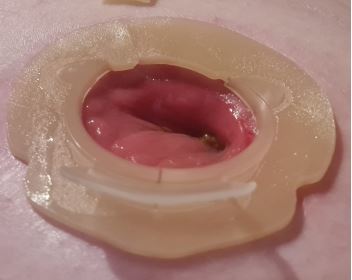
Feedback
After using the FLOWASSIST Seal, the patient reduced his pouch changes to only when it is full, which is usually once a day. His skin condition has improved as pancaking occurs very rarely. The patient is now much more confident going out and living his life.
Conclusion
The successful outcome of this case study highlights how the FLOWASSIST Seal can be effective in addressing pancaking issues. By mitigating pancaking and reducing the need for frequent pouch changes, the FLOWASSIST Seal has empowered the patient to regain control over their ostomy care and live more confidently.
Case Study 7: Unexplained Leakage in a Post-Op IBD Patient
Patient History
A 22-year-old female patient with a new end ileostomy and a history of long-term IBD experienced unexplained leakage. She has a good surgical stoma and tried various pouching systems, including a flat barrier ring. She tried convexity but found it too uncomfortable.
Intervention
The patient was introduced to the FLOWASSIST Seal, used in conjunction with a flat pouching system.
Feedback
The patient found the FLOWASSIST Seal comfortable and easy to fit. Although she changed her pouch daily, she believed it could last two days. Since using the FLOWASSIST Seal, she had not experienced any leaks. Her stoma nurses said the FLOWASSIST Seal prevented her from becoming a ‘problem patient’ as she would have developed skin complications had the leakage continued. They also emphasized the importance of a good early experience with the pouching system to help patients accept and adapt to their new life with a stoma.
Conclusion
The FLOWASSIST Seal enabled this patient to adapt to life with a stoma more easily. It prevented the development of sore skin caused by leakage and allowed the patient to go on her first post-surgery holiday without worrying about leaks.
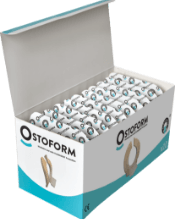
To learn more about the FLOWASSIST Seal and to request a free sample, visit https://ostoform.com/ostoform-seal-with-flowassist/
